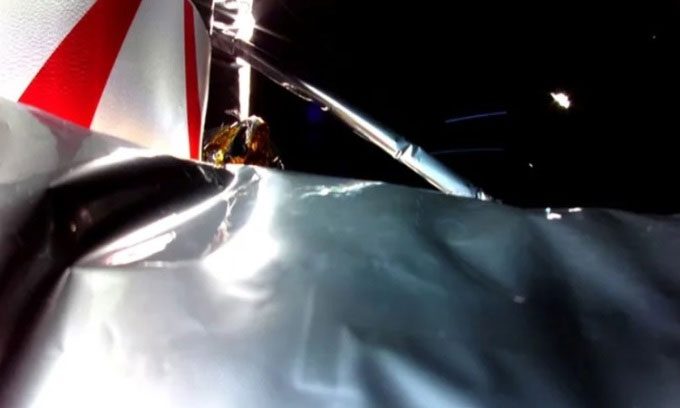Six hours after takeoff, the Peregrine lander from Astrobotic Technology encountered a technical issue that could jeopardize its lunar landing mission.
The Peregrine lander experienced a serious problem with its propulsion system on January 8, shortly after launching into space on the Vulcan Centaur rocket from United Launch Alliance (ULA). This issue will prevent Peregrine from reaching the Moon as planned, according to Space. “The malfunction within the propulsion system is causing fuel loss. The engineering team is working to resolve the issue, but given the circumstances, we prioritize maximizing scientific data collection,” stated Astrobotic Technology, based in Pittsburgh.

The first photo taken by the Peregrine lander after launch. (Photo: Astrobotic).
The launch of the Peregrine lander marks a significant milestone in space exploration, signaling the smooth debut of the powerful Vulcan Centaur rocket, which is set to replace ULA’s Atlas V and Delta rockets, and ushering in a new era of private lunar exploration.
Peregrine is part of NASA’s Commercial Lunar Payload Services (CLPS) program, aimed at transporting scientific equipment on autonomous private spacecraft. The lander is carrying five payloads from NASA, including radiation detection equipment and several spectrometers designed to search for traces of water ice beneath the lunar surface. According to NASA, promoting the development of private spacecraft will enable faster and cost-effective lunar research, thereby preparing for crewed missions to the Moon under the Artemis program. NASA also hopes CLPS will enhance the capabilities of the U.S. private space sector and stimulate off-Earth economic development.
NASA officials emphasize that each CLPS mission carries high risks. No private spacecraft has successfully landed on the Moon yet. “Every success and failure is an opportunity to learn and grow,” shared Joel Kearns, deputy manager for exploration at NASA’s Science Mission Directorate in Washington. “We will use this lesson to enhance our efforts in commercial development and scientific exploration of the Moon.”
NASA’s experiments are not the only payload that Peregrine is delivering to the Moon. The lander is carrying a total of 20 payloads, including Mexico’s first lunar probe and a memorial capsule from Celestis, a company specializing in space burial services. The spacecraft also carries cremated remains of notable individuals, including science fiction writer Arthur C. Clarke, Star Trek creator Gene Roddenberry along with his family, and many others. Additionally, it includes DNA samples from U.S. Presidents George Washington, Dwight Eisenhower, John F. Kennedy, and Ronald Reagan.
The malfunction threatens the first effort to land on the Moon by the U.S. since 1972, following the end of the Apollo program. To land on the Moon, the 1.3-ton Peregrine needs to adjust its engines to operate during controlled fuel burn sequences as it descends. Peregrine is scheduled to fly a trajectory to its final landing site, with a landing expected on February 23.
Astrobotic Technology is the first of three U.S. companies to send a lander to the Moon this year. Along with Intuitive Machines and Firefly Aerospace, they are collaborating with NASA and will launch five more missions to the Moon in 2024. The next private lunar lander under NASA’s CLPS program will be Nova-C, built by Intuitive Machines in Houston. Nova-C is set to launch on SpaceX’s Falcon 9 rocket in mid-February 2024 and land near the Moon’s south pole shortly thereafter.


















































